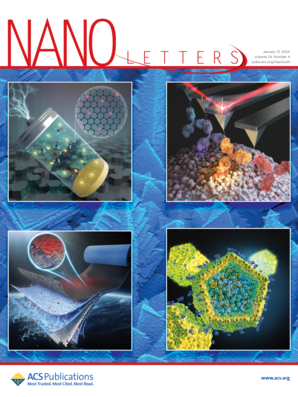Dipole–Dipole Interaction-Induced Direct Self-Assembly of Ag2S Quantum Dots into Supercrystals in Solution
IF 9.6
1区 材料科学
Q1 CHEMISTRY, MULTIDISCIPLINARY
引用次数: 0
Abstract
Long-range ordered supercrystals (SCs) built up by colloidal nanocrystals (NCs) represent a class of novel metamaterials with unique collective properties. While great attention has been paid to the ligand-controlled assembly of NCs, the contribution of the inorganic core is considered limited because of the weak core–core interactions. Here, we report the spontaneous assembly of Ag2S quantum dots (QDs) into three-dimensional SCs in solution, driven by pronounced dipole–dipole interactions. Dielectric spectroscopy shows a large permanent dipole moment of 516.7 D in 4.2 nm Ag2S QDs, and multiscale molecular simulation proves the dipole–dipole interaction-driven crystallization of Ag2S QDs. Moreover, we demonstrate that tuning the dipole–dipole interactions facilitates the formation of diverse nanostructures, including SCs, nanochains, and monodisperse nanoparticles. These findings offer a straightforward strategy for SC synthesis and establish the dipole–dipole interactions as a key driving force of NC self-assembly with broad implications for colloidal nanomaterials and their emergent functionalities.

偶极-偶极相互作用诱导Ag2S量子点在溶液中直接自组装成超晶体
胶体纳米晶体(NCs)构建的远程有序超晶体(SCs)是一类具有独特集体性质的新型超材料。虽然配体控制的纳米碳组装受到了极大的关注,但由于核-核相互作用弱,无机核的贡献被认为是有限的。在这里,我们报道了Ag2S量子点(QDs)在溶液中自发组装成三维SCs,由明显的偶极子-偶极子相互作用驱动。介电光谱显示,在4.2 nm Ag2S量子点中存在516.7 D的大永久偶极矩,多尺度分子模拟证明了Ag2S量子点的结晶是由偶极-偶极相互作用驱动的。此外,我们证明调整偶极子-偶极子相互作用有助于形成各种纳米结构,包括纳米链,纳米链和单分散纳米颗粒。这些发现为SC合成提供了一个直接的策略,并建立了偶极子-偶极子相互作用作为NC自组装的关键驱动力,对胶体纳米材料及其新兴功能具有广泛的影响。
本文章由计算机程序翻译,如有差异,请以英文原文为准。
求助全文
约1分钟内获得全文
求助全文
来源期刊

Nano Letters
工程技术-材料科学:综合
CiteScore
16.80
自引率
2.80%
发文量
1182
审稿时长
1.4 months
期刊介绍:
Nano Letters serves as a dynamic platform for promptly disseminating original results in fundamental, applied, and emerging research across all facets of nanoscience and nanotechnology. A pivotal criterion for inclusion within Nano Letters is the convergence of at least two different areas or disciplines, ensuring a rich interdisciplinary scope. The journal is dedicated to fostering exploration in diverse areas, including:
- Experimental and theoretical findings on physical, chemical, and biological phenomena at the nanoscale
- Synthesis, characterization, and processing of organic, inorganic, polymer, and hybrid nanomaterials through physical, chemical, and biological methodologies
- Modeling and simulation of synthetic, assembly, and interaction processes
- Realization of integrated nanostructures and nano-engineered devices exhibiting advanced performance
- Applications of nanoscale materials in living and environmental systems
Nano Letters is committed to advancing and showcasing groundbreaking research that intersects various domains, fostering innovation and collaboration in the ever-evolving field of nanoscience and nanotechnology.
 求助内容:
求助内容: 应助结果提醒方式:
应助结果提醒方式:


